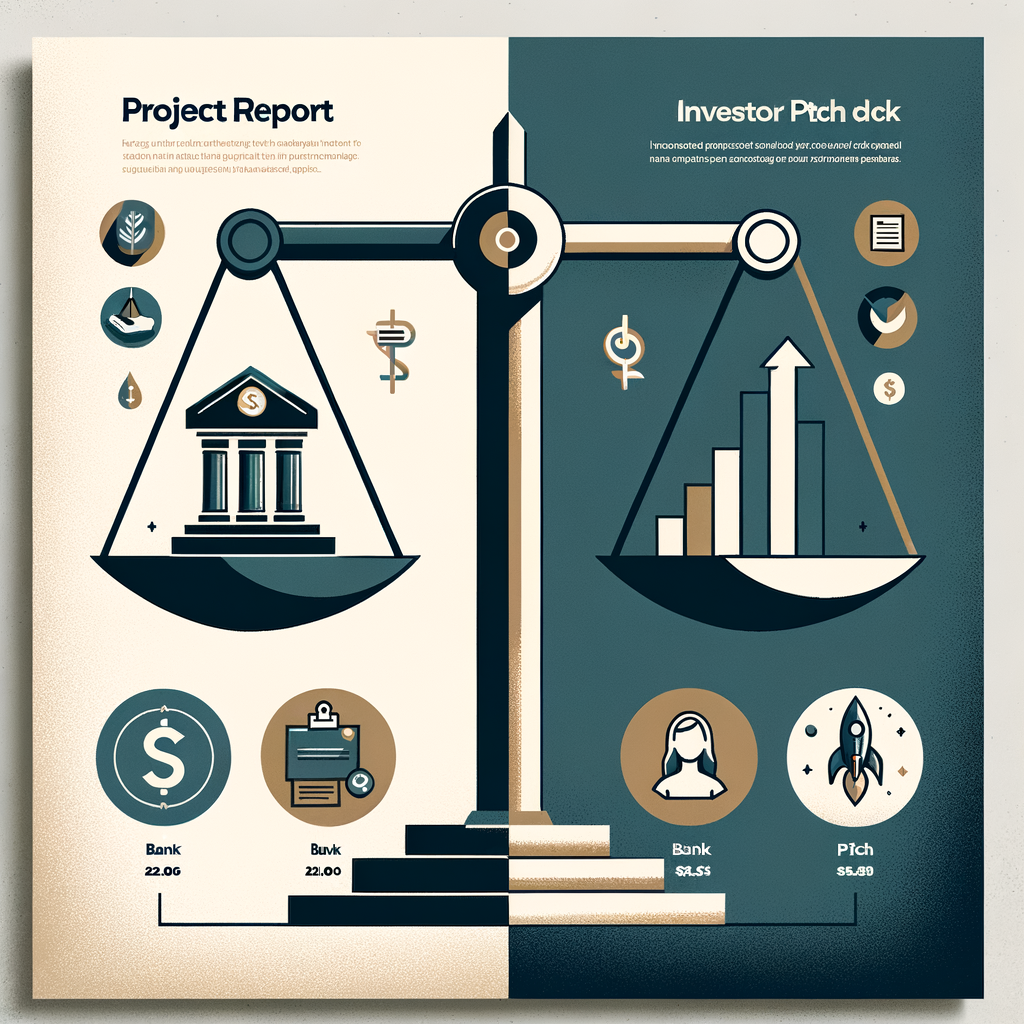What are the Differences Between Project Reports for Bank Loans and Investor Pitch Decks?
Securing funding is the first major milestone for any entrepreneur in India. Before seeking funds, however, it’s crucial to understand the basics of Starting a Startup in India: Legal and Tax Essentials. But the path to getting that capital diverges significantly depending on your source: a traditional bank or a modern investor. This is where two critical documents come into play and the project report vs pitch deck debate begins. While both the detailed project report for bank loan applications and the compelling investor pitch deck aim to secure funds, their purpose, audience, and content are fundamentally different. This guide will break down this comparison, helping Indian small business owners and aspiring entrepreneurs understand which document to create, what to include, and how to tailor it to successfully secure the business funding India offers.
Decoding the Project Report: Your Key to a Bank Loan
A project report for a bank loan is a formal, exhaustive, and data-driven document designed to convince a financial institution that your business proposal is a low-risk, viable venture. Its primary objective is not to sell a grand vision but to prove stability and demonstrate a clear capacity to repay the borrowed capital, along with interest, over a specified tenure. Think of it as a detailed blueprint that a banker, whose main job is to manage risk, can analyze to make a confident lending decision. The audience for this report consists of loan officers, credit risk managers, and approval committees within Indian banking institutions like SBI, HDFC Bank, or ICICI Bank. Their professional mandate is to protect the bank’s capital, so they scrutinize every detail to mitigate risk and ensure the loan can be recovered without default.
Essential Components of a Project Report for a Bank Loan
To satisfy the rigorous demands of bankers, your project report must be meticulous and comprehensive. It serves as the single most important document in the loan appraisal process, and its quality can directly influence the outcome.
Here are the non-negotiable components you must include:
- Promoter’s Profile: This section introduces the entrepreneurs behind the business. It must go beyond a simple name and title. You need to detail each promoter’s educational background, specific industry experience relevant to the project, past business ventures, and personal financial standing. A crucial element here is the CIBIL score, which gives the bank a clear picture of the promoter’s creditworthiness and past financial discipline.
- Project Details: Here, you outline the operational and technical aspects of your business. This includes its legal structure (e.g., Sole Proprietorship, Partnership, Private Limited Company), the proposed or existing location, a detailed list of required plant and machinery with cost estimates, and a practical implementation schedule with clear milestones and timelines.
- Detailed Financial Projections: This is the heart of the project report and receives the most scrutiny. You must provide projected financial statements—including the Profit & Loss Statement, Balance Sheet, and Cash Flow Statement—for the next 5 to 7 years. These are not just optimistic guesses; they must be based on well-researched assumptions about sales, costs, and market conditions. A key calculation that banks look for is the Debt-Service Coverage Ratio (DSCR), which measures your company’s available cash flow to pay its current debt obligations. A DSCR of 1.5 or higher is generally considered healthy.
- CMA Data (Credit Monitoring Arrangement): For most business loans in India, banks mandate the submission of financial data in a standardized format known as CMA Data. This systematic presentation includes an analysis of past performance and future projections, covering seven key statements from the analysis of the balance sheet to the calculation of the Maximum Permissible Bank Finance (MPBF). Preparing accurate CMA data for a bank loan is critical, as it allows the credit analyst to uniformly assess your company’s financial health. For professional help in compiling these statements, you can consult experts like those at TaxRobo Accounts Service.
- Break-Even Point Analysis: This calculation shows the bank the exact point at which your total revenues equal your total costs, meaning you are no longer making a loss. It demonstrates that you have a deep understanding of your cost structure and the sales volume required to become profitable.
- Repayment Schedule: Finally, you must present a clear, tabulated schedule that details how the loan principal and the accrued interest will be repaid over the entire loan tenure. This schedule must align perfectly with your cash flow projections, proving that the business will generate sufficient funds to meet these obligations on time.
Tone and Focus
The tone of a project report should be completely objective, factual, data-driven, and formal. There is no room for visionary hyperbole or persuasive marketing language. Your focus must be squarely on risk assessment, financial soundness, collateral security, and repayment capacity. Use clear, unambiguous language and ensure every claim is backed by data, whether it’s a market research report, a quotation for machinery, or a detailed cost analysis. The goal is to build confidence through numbers and logic, not through passion and storytelling.
Mastering the Investor Pitch Deck: Winning Over Investors
In stark contrast to the project report, an investor pitch deck is a brief, visually engaging, and persuasive presentation, typically delivered in 10-15 slides. Its purpose is to spark an investor’s imagination and convince them that your business has immense growth potential and can deliver a massive return on their investment. It’s not about proving you can repay a loan; it’s about selling a compelling vision of market disruption and scalability. The entire presentation is an answer to the question, ‘How can I pitch my startup idea to potential investors successfully?‘. The target audience for a pitch deck includes Angel Investors, Venture Capitalists (VCs), and other equity investors. These individuals or firms are not risk-averse in the same way bankers are. They take calculated risks on high-growth ventures, expecting that one successful investment will generate returns of 10x, 20x, or even 100x to compensate for other failed ventures in their portfolio.
Key Slides in an Investor Pitch Deck
An effective investor pitch deck for Indian startups tells a story. Each slide builds upon the last, creating a narrative that is both logical and exciting. The structure is designed to answer an investor’s key questions quickly and efficiently.
Here are the essential slides every pitch deck must have:
- The Problem: Start by articulating a significant and relatable customer pain point. A powerful problem statement makes the investor understand the need for a solution and immediately engages them in your story.
- The Solution: Present your product or service as the unique, elegant, and effective solution to the problem you just outlined. Use visuals or a short demo to show how it works and why it’s better than existing alternatives.
- Market Size (TAM, SAM, SOM): Investors want to see a huge market opportunity. You need to quantify this using the TAM, SAM, SOM framework (Total Addressable Market, Serviceable Available Market, Serviceable Obtainable Market). This demonstrates that your business isn’t a niche player but is targeting a large, lucrative space.
- Business Model: Clearly explain how your business makes money. Is it a subscription model (SaaS), a one-time purchase, transaction fees, advertising, or a freemium model? Investors need to see a clear and scalable path to revenue generation.
- The Team: This is one of the most critical slides. Introduce your core team members and highlight their relevant experience, past successes, and unique skills. Investors often say they bet on the jockey, not the horse. Prove that you have the right team to execute the vision and navigate challenges.
- Traction: Show, don’t just tell. This slide is your social proof. Showcase what you have already achieved. This could be the number of active users, monthly recurring revenue (MRR), key strategic partnerships, customer testimonials, or impressive user engagement metrics. Traction proves that your concept is viable and that customers want what you’re building.
- Competitive Advantage (USP): What is your “secret sauce”? Clearly explain what makes you different from and better than the competition. This could be proprietary technology, a unique business model, an exclusive partnership, or a network effect that is difficult to replicate.
- The ‘Ask’ and Use of Funds: Be specific and confident. State exactly how much startup funding or venture capital funding you are seeking. More importantly, provide a clear breakdown of how you will use these funds (e.g., 40% for marketing, 30% for product development, 30% for hiring) to achieve specific growth milestones over the next 12-18 months.
Tone and Focus
The tone of a pitch deck should be visionary, persuasive, confident, and highly engaging. Use powerful visuals, graphics, and charts to complement your narrative. Storytelling is key. Your focus is on growth potential, scalability, market disruption, the strength of your team, and the promise of exponential ROI. You are selling the future, and your confidence in that future must be palpable.
Project Report vs Pitch Deck: A Side-by-Side Comparison
To make the distinction crystal clear, here is a direct comparison of the two documents across key features. Understanding this table is fundamental for any entrepreneur planning their approach to business funding India.
| Feature | Project Report for Bank Loan | Investor Pitch Deck |
|---|---|---|
| Primary Goal | To secure a debt facility (loan) | To secure an equity investment |
| Target Audience | Bankers & Credit Analysts | Angel Investors & Venture Capitalists |
| Core Focus | Financial viability, risk mitigation, and repayment capacity | Growth potential, scalability, and market disruption |
| Tone | Formal, objective, data-heavy | Persuasive, visionary, engaging |
| Content | Highly detailed, exhaustive financials (CMA Data) | High-level summary, key metrics, and storytelling |
| Document Length | 25-100+ pages | 10-15 slides |
| Financials | Detailed 5-7 year projections, ratio analysis (DSCR) | Financial highlights, unit economics, and “The Ask” |
| Desired Outcome | Loan sanction | Secure a follow-up meeting or a term sheet |
Conclusion
For a dedicated look at the bank loan process, see our guide on Bank Loan for Startup Business. Ultimately, the project report vs pitch deck debate is settled by your funding goal and your audience. The two documents serve entirely different purposes and speak to two very different mindsets. A project report for a bank loan is a defensive document; it proves you are a safe bet, meticulously detailing your ability to honor a debt obligation. In contrast, an investor pitch deck is an offensive document; it proves you are a winning horse, painting a compelling picture of future growth and promising exponential returns on an equity investment.
Understanding this fundamental distinction is crucial for any Indian entrepreneur navigating the complex world of capital raising. Preparing the right document, with the right tone and content for the right audience, will drastically increase your chances of securing the business funding your venture needs to thrive.
Whether you need a meticulous project report for a bank loan that meets all of RBI’s norms or a powerful investor pitch deck that excites VCs, the journey can be complex. Let TaxRobo’s financial experts guide you. Contact us today to get professional assistance tailored to your funding needs.
Frequently Asked Questions (FAQs)
1. Can I use my investor pitch deck to apply for a bank loan in India?
No, you absolutely cannot. A pitch deck is a high-level summary designed for investors and completely lacks the granular financial analysis, risk assessment, and detailed projections that Indian banks require for a bank loan for business. Banks need to see exhaustive documentation like projected balance sheets, cash flow statements, and specifically, the CMA data, which are never part of a pitch deck. You must prepare a separate, detailed project report.
2. What is the most important section in a project report for a bank?
While every section is important, the financial projections section is the most critically scrutinized part of the report. Within this section, the Cash Flow Statement and the calculation of the Debt-Service Coverage Ratio (DSCR) are paramount. This is because they directly and objectively show the bank your business’s ability to generate enough cash from its core operations to make its loan payments on time, every time.
3. How much does it cost to prepare a professional project report in India?
The cost of preparing a professional how to prepare project report for bank loans can vary significantly. It depends on factors like the complexity of your business model, the scale of the project, and the loan amount requested. For a simple small business or MSME loan, it might cost a few thousand rupees. For a large, complex industrial project with intricate financial modeling, the cost can be substantially higher. Consulting a professional firm like TaxRobo Online CA Consultation Service ensures the report is accurate, compliant, and cost-effective.
4. Do I need a project report for a MUDRA loan?
The documentation requirements for a MUDRA loan depend on the scheme. For smaller loans under the ‘Shishu’ scheme (up to ₹50,000), the application process is simplified, and a formal project report may not be required. However, for larger loan amounts under the ‘Kishor’ (₹50,001 to ₹5 Lakh) and ‘Tarun’ (₹5 Lakh to ₹10 Lakh) schemes, banks will almost certainly require a basic project report. This report should outline your business plan, the cost of the project, and your projected income to help the bank assess the venture’s viability. For official details, you can visit the Mudra Yojana Portal.



